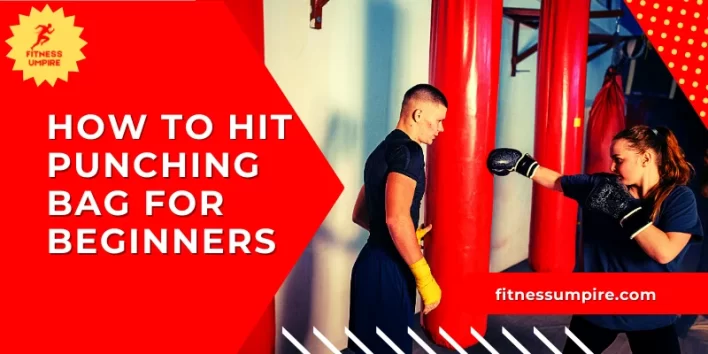
Punching bags are a great way to get in shape, improve hand-eye coordination, and develop strength and endurance. However, if you’re new to boxing or martial arts, punching the bag can be intimidating. In this article, we’ll take a closer look at how to hit a punching bag for beginners, and how to get started.
This comprehensive guide provides step-by-step instructions and is your go-to resource for mastering the art of hitting a punching bag. Start your boxing journey with confidence and learn the skills needed to make the most out of your training sessions.
How to Hit a Punching Bag for Beginners: Techniques, Tips, and Mistakes to Avoid
When it comes to boxing and combat sports, hitting a punching bag is an essential skill to master. Whether you’re a beginner looking to learn the basics or someone seeking to improve their technique, this article is for you.
You will learn the fundamental techniques, offer tips for developing power and speed, discuss footwork and movement, and highlight common mistakes to avoid.
Mastering the art of punching the bag is essential in boxing, especially for beginners. This article delves into the importance of learning proper punching bag technique and the benefits it brings.
The Importance of Learning Proper Punching Bag Techniques
Build the foundation for your boxing journey by learning proper punching bag technique. It helps you develop proper posture, build strength and prevent injury. By understanding the intricacies of hitting the punching bag, you can maximize your workout and make effective progress.
Benefits of hitting punching bag for beginners
Punching bags have many benefits for beginners. It’s a great cardiovascular exercise that improves stamina, strength, and overall fitness. It helps you strengthen your upper body, core and legs. Additionally, punching the bag is an effective stress reliever that can help improve coordination and concentration.
Understand the basics
Before starting to actually throw punches, the basics of punching the bag must be mastered.
1. Choosing the Correct Punching Bags and Handwraps
Choosing the right punching bag for your goals and experience level is critical. Additionally, wearing a hand wrap provides essential support and protection for your hands and wrists.
Wrap your thumb around the outside of the glove, not the inside. This will help you maintain a firm grip and prevent injury.
2. Warming Up and Stretching Exercises
Warm up your muscles and joints with dynamic exercises before punch bag exercises. Incorporate stretching exercises to increase flexibility and reduce the risk of injury.
Do a few minutes of light aerobic activity, such as jumping jacks or running in place, to get your heart rate up. Then, do some dynamic stretches to relax your muscles and prevent injury.
3. Proper Posture and Hand Position
Building a solid boxing stance and proper hand position is the foundation. Maintain a balanced and stable posture with feet shoulder-width apart, knees slightly bent, and weight evenly distributed. Put your hands in a defensive position, protecting your face and chin.
Fundamental Punches
Mastering the basic punches is an essential element to hitting the bag effectively.
1. The Jab: Technique, Execution and Variations
The jab is a quick, direct punch with your front hand. Focus on maintaining proper form, fully extending your arms, and then quickly retracting them. Explore different jab variations, such as double jab or cross jab combinations, to diversify your punching mix.
2. Cross: Generate power and maintain balance
A cross is a powerful punch delivered with the backhand. Rotate your body and hips, shift your weight from the back foot to the front foot, and engage your core muscles to generate maximum power. Remember to keep your balance and retract your fist quickly.
3. Hook: Proper Form and Target
The hook is a curved punch executed with a curved arm. Rotate your body and hips to center on your forefoot and deliver the punch in a sweeping motion. Aim for the side of the bag or the temple area for effective aiming.
Develop strength and speed
To enhance punching bag training, focus on the development of strength and speed.
1. Incorporate body rotation for a stronger punch
Use proper body rotation and weight transfer to generate more punching power. Begin the movement with the legs and glutes, allowing power to pass through your core and into your arms.
2. Increase speed through Shadow Boxing and combination training
Tai Chi is an excellent exercise for developing speed and precision. Practice punching in the air, focusing on technique and speed. Incorporate combination exercises to enhance your mobility and accuracy.
3. Use proper breathing techniques
Breathing is critical to maintaining energy and strength during bag training. Practice exhaling forcefully with each punch to engage your core muscles and increase your overall power output.
Footwork and movements
Footwork is critical in boxing and bag training, allowing you to create angles and deliver punches effectively.
Good footwork is key when hitting the bag. As you punch, pivot with your rear foot, shifting your weight to your front foot. This will help you generate power and speed, and it will also help you maintain your balance.
1. The importance of footwork in boxing and punching bag training
Proper footwork allows you to maintain your balance, dodge attacks, and position yourself for effective strikes. Focus on footwork drills and exercises to improve agility, speed and overall movement.
2. Shift weight and maintain balance when punching
As you punch, shift your weight from one foot to the other, maintaining a balanced and stable stance. This weight transfer enhances the power and efficiency of the punch.
3. Practice different angles by moving around the bag
Go around the sandbag and practice hitting the ball from different angles. This mimics the movements and positions required in an actual boxing match, improving your adaptation and reflexes.
Common Mistakes to Avoid
To optimize your punching bag workouts, avoid these common mistakes.
1. Overwork and poor rhythm
Avoid going all out from the start. Tempo yourself and gradually increase the intensity of your punches. Overexertion can cause fatigue and damage your shape.
2. Improper Posture and Hand/Wrist Alignment
Maintaining proper form is critical to preventing injury. Make sure your wrist is aligned with your forearm and you are throwing the punch with proper technique.
3. Neglect of defense and footwork
Don’t just focus on offense. Combine defensive techniques and footwork such as slips, weaves and lateral moves to improve your overall boxing skills.
Tips for Effective Workouts
To get the most out of your punching bag training, implement these tips.
1. Set goals and track progress
Create specific goals for your workouts, whether it’s improving technique, increasing strength, or building endurance. Keep a training journal to track your progress and celebrate milestones.
2. Different punch combinations and intensities
Keep challenging yourself by combining different punch combinations and varying the intensity of your workout. This can keep your training sessions engaging and help you develop versatility.
3. Combine interval training with rest periods
Incorporate interval training into your punching bag workouts, alternating between high-intensity workouts and periods of rest. This builds your cardiovascular endurance and replicates the intensity of an actual boxing match.
4. Punching Technique
As a beginner, you should start with some basic punches. The most common are the jab, cross and hook. Start with the jab, a quick and direct punch that you can use to test the bag and get used to hitting it. Then, add the cross and hook, which are more powerful punches that require more technique and coordination.
5. Speed and Power
When hitting the ball, it’s important to focus on speed and power. Make sure you hit the bag as fast and as hard as you can while still maintaining control and good form. The more you practice, the faster and stronger you will become.
6. Calm down
After punching the bag, it’s important to calm down. Do some light cardio and static stretching to help your muscles recover and prevent injury.
Conclusion
As a beginners, punching the bag is an excellent way to improve your boxing skills, fitness and overall health. By learning proper technique, understanding the basics, and avoiding common mistakes, you can make significant progress in your boxing journey.
Remember to focus on footwork, build strength and speed, and prioritize safety during your workout. Embrace the benefits of punching the bag, from building strength and coordination to relieving stress and boosting confidence. With dedication and practice, you’ll become a skilled boxer and enjoy the many rewards that this exhilarating sport has to offer.
I hope you may find this article helpful about how to hit punching bag for beginners. So what are you waiting for? put on your gloves and start hitting that bag!
